- This page contains pictures and information about Bees in Superfamily APOIDEA
that we found in the
Brisbane area, Queensland, Australia.
-
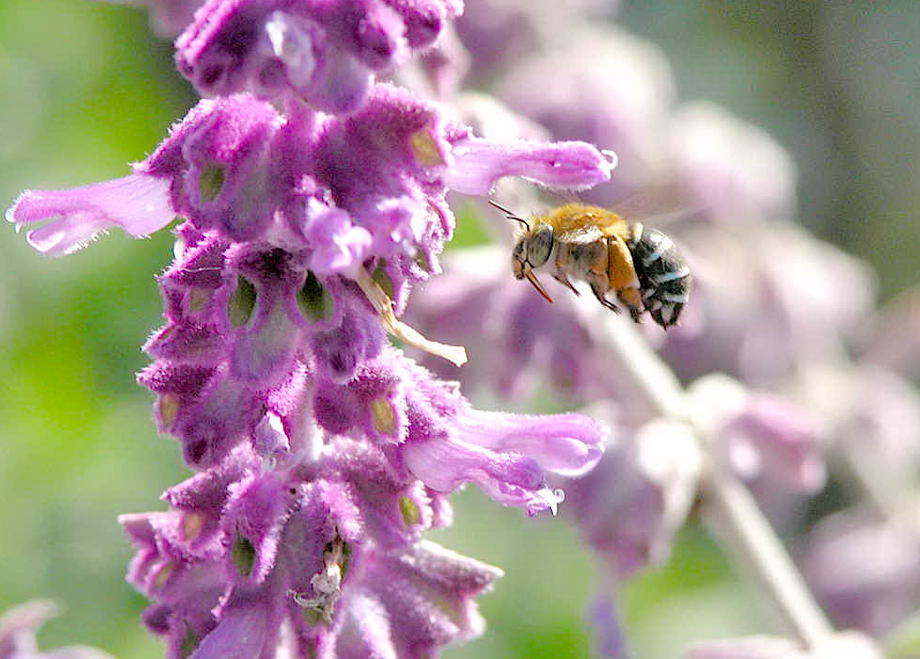 - The long-tongued Blue-banded Bee
-
- Bees ,superfamily APOIDEA, belong to the insect Order Hymenoptera,
which includes
parasitic wasps, stinging
wasps, ants and sawflies.
-
- Most bees live as individual, although the famous Honey Bees are social insects. The solitary bees live in burrow under ground or in tree stems.
In their nests, there are chambers for their larvae. Beside there are the
storage area for the nectar and pollen. Some bee species live together and using the
same entry, although each have their own nest and look after their own young. Some
bee species are social insects, only the queen lay eggs. Other members are the sterile
workers in large colony.
-
- Both wasps and bees visit flowers.
Sometimes
it may be hard to distinguish
them. Wasp larvae are either carnivorous or parasitic while all bee larvae are
vegetarian. Bee larvae feed on pollen. Bees carry pollen by the hairs on their
legs and body. In general we distinguish them by bees with hairy body and legs
while wasps with
very little hairs on body and legs.
-
- Unlike other members in Hymenoptera, bees' mouthparts are modified to a
hairy tongue. The tongue is used for sucking up nectar from flowers. When rest bees
fold the tongue inside mouth in Z-shape. Besides the tongue, bees' mouthpart have
two strong mandibles, functioning as holding-hands more than cutting-teethes.
Their mandibles are used for building hive, dragging,
fighting and feeding the larvae.
-
- In Australia we have the five major bee families, Colletidae,
Halictidae, Megachilidae,
Anthophoridae and Apidae. Some reference books group Anthophoridae into Apidae
as one family.
-
- None of these bees pose a serious threat to us, although the females do possess stings.
-
-
-
- FAMILY
COLLETIDAE - Colletid Bees, Short-tongued Bees
- Colletid Bees are short tongue bees. They are
from small to medium in size. They
burrow in ground, especially in clayey soil. Some of them are hairy and some
are not.

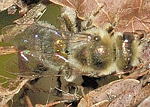
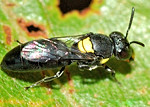 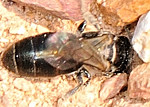
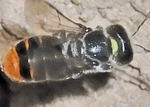
 -
- FAMILY HALICTIDAE - Halictid Bees, Burrowing Bees
- Bees in this family are usually black with metallic colours. They are
solitary (each female bee build nest, lays and cares her own eggs) or
communal (share nest with other female but care her own eggs). Females nest in
ground or rotting wood, males do not nest but cluster together at night.



 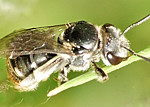 -
- FAMILY MEGACHILIDAE -
Leafcutter Bees and Resin Bees
- Leafcutter bees are common in Brisbane gardens. They are visitors of different flowering plants.
Sometimes we find circular holes in soft-leaved plants, these are made by the female
bee which uses the leaf to build her nest. She provides each egg with pollen and nectar.
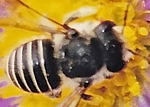 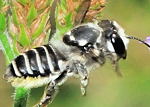

 -
- Family ANTHOPHORIDAE
- Giant Bees
- This family contains some largest bees in Australia. They make nests in
dead tree branches or underground. They are solitary bees. Some members in
this family, like the Carpenter Bees and Blue-banded Bees, are known as buzz
pollinators. They use special technique to get pollen from flowers.
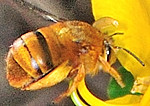 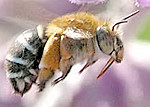
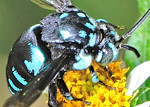 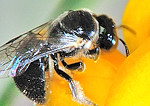
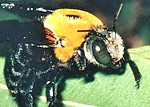 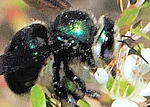
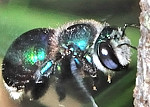
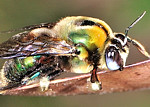
- Family APIDAE
- Social Bees
- The Apidae family includes the famous Honey Bees and the
Australian Native Stingless Bees, they are the
highly social insects. There are also the solitary
and communal species in this family. Most of them have modified mouthparts
likes a tongue which can sip nectar easily. Another characteristic are their
hairy legs and pollen baskets that they used for collecting pollen and nectar
for their young.
-
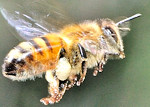
 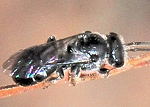
- Reference:
- 1. Insects
of Australia, CSIRO, Division of Entomology, Melbourne University
Press, 2nd Edition 1991, pp 993.
- 2. Insects of Australia and New Zealand - R. J. Tillyard, Angus
& Robertson, Ltd, Sydney, 1926, p301.
- 3. Photograph Gallery of Australian Native Bees - © 1997-2008 Australian Native Bee Research Centre.
- 4. What
wasp is that? - An interactive identification guide to the
Australasian families of Hymenoptera, 2007.
- 5. Northern
Territory Insects, A Comprehensive Guide CD - Graham Brown, 2009.
- 6. Native
Bees of the Sydney region, a field guide - Anne Dollin, Michael Batley,
Martyn Robinson & Brian Faulkner, Australian Native Bee Research Centre.
- 7. Superfamily APOIDEA Social Bees, Solitary Bees - Australian Faunal Directory, Australian Biological Resources Study.
[ COLLETIDAE ] [ HALICTIDAE ] [ MEGACHILIDAE ] [ ANTHOPHORIDAE ] [ APIDAE ] [ Unknown Bees ]
|